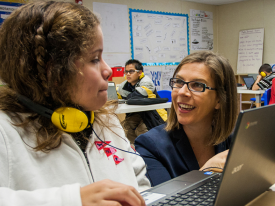Street Data: A New Grammar for Educational Equity
Topics

Together, educators are doing the reimagining and reinvention work necessary to make true educational equity possible. Student-centered learning advances equity when it values social and emotional growth alongside academic achievement, takes a cultural lens on strengths and competencies, and equips students with the power and skills to address injustice in their schools and communities.
Whose voices are included, tokenized, and silenced as we address equity in our schools? Gain insight and feel empowered to experiment with the strategic use of "street data" to be more inclusive.
We are at a crossroads in the movement for equitable schools. While equity has entered the popular discourse in education, we are struggling to transform our fundamental paradigm of how schools operate—a paradigm born of inequity. Consider this historical nugget: In 1779, Thomas Jefferson proposed a two-track educational system with different tiers for, in his words, "the laboring and the learned." Scholarship would allow a very few of the laboring class to advance, Jefferson says, by "raking a few geniuses from the rubbish." Or how about the fact that in 1932, a survey of 150 school districts revealed that three-quarters of them were using so-called intelligence testing to place students in different academic tracks? (For more on this history, visit the Historical Timeline of Public Education in the U.S. at Race Forward's website.) The relics of these historical moments persist like vestigial organs in a system built for racial and economic stratification.
This is the underbelly of American public education; yet even as we proclaim a commitment to equity, we continue to use many of the tools that built this very system—from tracking to Pavlovian bell schedules to standardized tests that are rooted in the history of eugenics. Author and scholar Jal Mehta wrote in his recent piece "Why Equity Has Been a Conservative Force in American Education—And How That Could Change":
Even as the legal requirements for NCLB have ended, the mindset has persisted. Urban schools and districts continue to be run in more authoritarian ways than their suburban counterparts, and students in disadvantaged schools continue to be more subject to test-driven pressures.
Put simply, our well-worn tools are not helping us rebuild the house. We need to radically reimagine the mindset and methodology of working toward equity so that our process is as liberating as the vision we espouse. This begins with transforming our concept of data.
From Satellite to Street Level
In my book, The Listening Leader: Creating the Conditions for Equitable School Transformation (John Wiley and Sons, 2017), I offer an equity-centered framework I call the Levels of Data. Drawing on the work of W. James Popham, I argue that we are using the wrong data to make our most important educational decisions and, as a result, further marginalizing the students we claim to want to serve.

Level 1 "satellite" data, such as test scores, attendance patterns, and graduation rates, tell an important but incomplete story of equity. While satellite data can illuminate big performance trends and point toward underserved student groups, it has a few fatal flaws.
First, it tends to be lagging, falling into educators' hands long after it has lost its utility to inform instructional decisions. Second, it gives policymakers and system leaders unwarranted credibility to make sweeping decisions without being close to the actual locus of learning—the classroom. Finally, and perhaps most problematically, it serves to reinforce implicit biases against African American, Latino, and other students of color by insinuating that they have less intellectual capacity rather than having disparate access to resources. Satellite data lacks context and nuance, failing to account for phenomena like stereotype threat, a theory developed by psychologist Claude Steele to describe how the performance of women, people of color, and others can often decrease with the psychic threat of being viewed as inferior.
Level 2 "map" data hovers closer to the ground, providing a GPS of learning trends and gaps in a school community. Map data could include Lexile levels gathered through running record assessments, rubric scores on a common math assessment, or student perception data gleaned from a schoolwide survey. While this data paints a slightly richer picture, it still lacks the texture required to inform and shape equitable change.
By contrast, Level 3 "street data" takes us down to the ground to listen to the voices and experiences of our students, staff, and families. It provides us with real-time, leading indicators on the messy work of school and instructional improvement while enabling rapid feedback loops for our decisions and practices. Street data offers a new grammar for educational equity rooted in a few guiding principles. First and foremost, it's about humanizing the process of gathering data. Rather than positioning students and families as objects whose value can be quantified, street data teaches us to engage with people as subjects and agents in an ever-shifting landscape whose experiences are worthy of careful study and deep listening. It teaches us to be ethnographers rather than statisticians. And the process itself, if done well, builds trust and relational capital.
Equally important, street data helps us center the voices of those currently at the margins of our schools and systems. Rather than succumb to Paolo Freire's notion of false generosity, where we assume to know what's best for those we serve, we assume a stance of humility and learning. This simple shift in perspective disrupts the tendency toward superiority that maintains white supremacy. Lastly, street data helps us embrace a bias toward action and rapid cycles of learning-doing. When we ground our leadership moves at the street level—whether in the classroom, the staffroom, or the community—we begin to acquire critical insight into what's working and what's not.
Picking up the mantle of street data would have offered the leader an opportunity to elevate the voices of those marginalized in his system and, ultimately, to change the conversation.
My book outlines many ways to collect street data from parents, students, and staff. Here is a short sampling:
- Shadow a Student: Put on your comfy shoes and, with permission of course, follow a student through his or her school day. This is particularly impactful if done by a network of leaders and focused on students who are currently outside the sphere of success.
- Audio Feedback Interviews: Conduct an audio-recorded focus group with students or parents whose voices are typically absent from the decision-making table.
- Equity Participation Tracker: When you visit a classroom, track who is being called on, who is volunteering to speak, and who is receiving positive vs. negative feedback (both verbal and nonverbal cues). Break this data down by key axes like race, English-language learner status, gender, and special education.
- Real-Time Fishbowls: Physically center the missing voices of key stakeholders in your professional development meetings by hosting a fishbowl conversation—a facilitated circle dialogue in the center of the room with others positions outside the circle as listeners. For example, a district leader could facilitate a fishbowl with principals, asking, "What is your daily experience like as school leader? What conditions do you need to be successful? What could we do differently to support you?" Be willing to listen—even when it's hard to hear.
Idaho: A One-Inch Window into the New Grammar
Let's take a peek into one district to see how the old tools and scripts could be replaced by the new grammar of street data. Last fall, an Idaho superintendent issued a public apology and placed 14 employees on paid leave after a public relations debacle at a local elementary school. More than a dozen adults had dressed up for Halloween as either stereotypical caricatures of Mexicans (replete with maracas, ponchos, sombreros and fake mustaches) or segments of a wall plastered with the Make America Great Again slogan. (See this Washington Post story for more.)

Some adults at an Idaho elementary school dressed up for Halloween as either stereotypical caricatures of Mexicans or segments of a wall with the Make America Great Again slogan. (Screenshot from Middleton School District Facebook)
The superintendent's apology was somber, contrite, and a stark artifact of the old grammar. Said Superintendent Josh Middleston in a now-private Facebook video:
We embrace all students. We have a responsibility to teach and reach all students. Period. Do I think that there was a malicious intent in this poor decision? No, I don't. Was there a poor judgment involved? Absolutely.
As logical as this response might sound at face value, it carries a few problematic assumptions. First, that this event is an outlier; second, that our system is designed to serve and support all children; and finally, that our intention is to serve and support all students so, aggrieved parents and students, please forgive us.
On the flip side, parents who were hurt by this event began to speak out. Said one parent, "Unfortunately, this is the environment that children are going to school in." She continued, "As a mother to a minority child, I would be mortified if this were my child's teacher." Were the superintendent to embrace the new grammar of street data, what could he have done or said differently?
Pause. Equity breaches like the Halloween costume incident are painful moments for leaders to pause, breathe, and reflect. They can be opportunities for either reproduction of the status quo or rebirth of an authentic commitment to equity. As a leader, I might ask myself, What is the expected, boilerplate response? How can I flip the script and take ownership over this moment, rather than externalizing blame? The Idaho superintendent could have said, "Wow, this is really a moment of reckoning for us as a system, and me as a leader. We clearly have some underlying racial tensions that are impacting our students and families of color in a deep way. It is time for us to pause, dig into the root causes of this incident, and listen and learn from our community."
Listen to those most impacted. The superintendent and his team could have immediately scheduled a series of listening sessions with the parents and students impacted by this incident. Here is an opportunity for humility and deep listening, focused on questions of humanity rather than quick fixes! He might have asked affected parties, How did this incident impact you? Have you experienced, witnessed, or heard of similar incidents? What do you think we need to do as a district to better educate our staff and to ensure that every school provides a safe learning environment for every child?
Lift up street-level voices. The superintendent could have then leveraged this street-level data to drive reflection and cultural change across the organization. For example, he could have facilitated a fishbowl dialogue or a panel of parents whose children were hurt by the costumes. He could have posted anonymous quotes from the listening sessions at a system-wide staff meeting, asking school leaders and teachers in the room to silently walk and take in the quotes. Picking up the mantle of street data would have offered the leader an opportunity to elevate the voices of those marginalized in his system and, ultimately, to change the conversation.
Closing Thoughts
Street data offers us a new grammar for working toward equity. Rather than rely on quantitative metrics that repeatedly tell the same, deficit-based story about our underserved students, let's start to listen to the voices and lived experiences of those we aspire to serve. Let's demonstrate humility, deep thinking, and a commitment to the kind of rigorous reflection that breaks the cycle of inequity. As the late author Audre Lorde wrote, "The master's tools will never dismantle the master's house." It's time to pick up a new set of tools and boldly construct a vision of a new, humanizing system.




